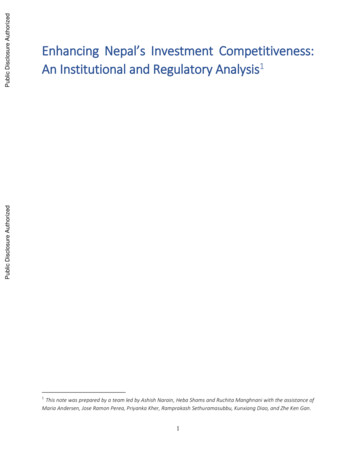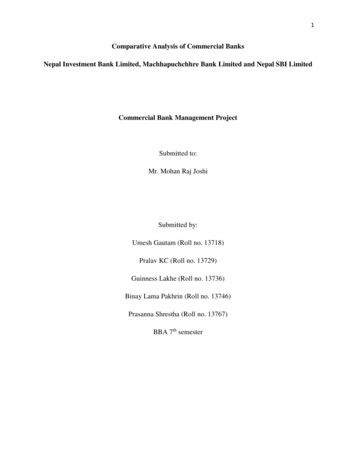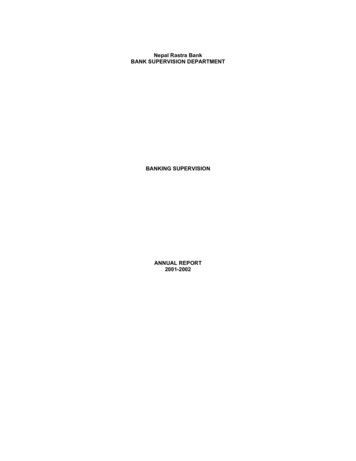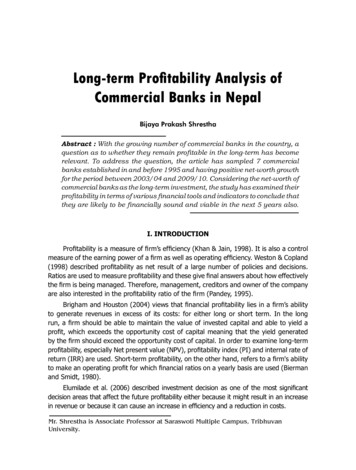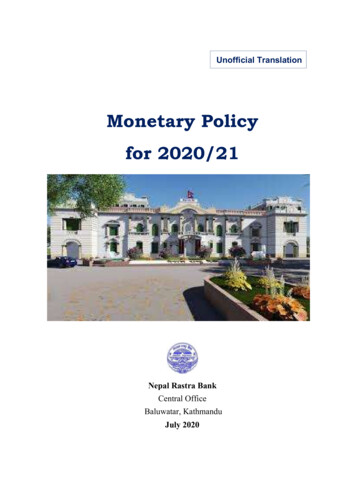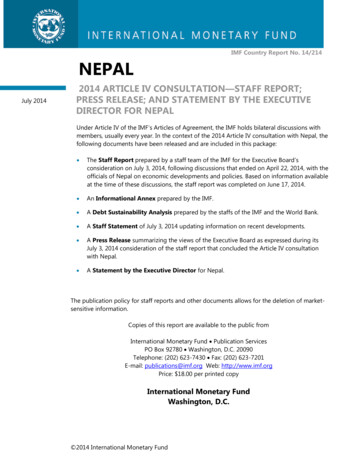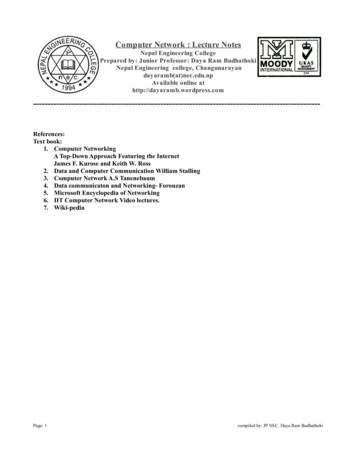
Transcription
Computer Network : Lecture NotesNepal Engineering CollegePrepared by: Junior Professor: Daya Ram BudhathokiNepal Engineering college, Changunarayandayaramb(at)nec.edu.npAvailable online ------------------------------References:Text book:1. Computer NetworkingA Top-Down Approach Featuring the InternetJames F. Kurose and Keith W. Ross2. Data and Computer Communication William Stalling3. Computer Network A.S Tanenebaum4. Data communicaton and Networking- Forouzan5. Microsoft Encyclopedia of Networking6. IIT Computer Network Video lectures.7. Wiki-pediaPage: 1compiled by: JP NEC. Daya Ram Budhathoki
Table of ContentsChapter1: Emergence of Network , principle of communication Network and Multiplexing.7What is computer Network?.7Historical Events:.8Modes of communication:.9Protocol:.10Principle of Communication:.11Elements of f-duplex.14Chapter2: Network Topology and Architecture.15Local Area Network (LAN).15MAN:.15WAN: .16LAN Vs :.19Physical Topology and Logical Topology:.20Bus Topology:.21Ring Topology.21Mesh Topology:.22Star Topology:.22Logical Topology:.23Network Architecture:.23Peer-to-Peer Model:.23Client-server Model:.24Wireless LAN:.26Wireless Standards - 802.11b 802.11a 802.11g and 802.11n.27Wireless Topologies:.27Chapter3: OSI Reference Model:.29Network Software:.29Protocol Hierarchies.29Layer Communication:.29OSI Model.30Peer-to-Peer Communication:.31Data Encapsulation:.31Seven Layers of OSI Reference Model:.321. Physical Layer:.322. Data Link Layer:.323. Network Layer:.33Page: 2compiled by: JP NEC. Daya Ram Budhathoki
4. Transport Layer:.335. Session Layer:.346. Presentation Layer: .347. Application layer:.35Devices and Protocols on each Layer:.35Chapter4: Physical layers and its Design issues:.36Transmission Medium:.36Shielded Twisted-Pair (STP) Cable .36Unshielded twisted-pair (UTP) .37UTP Cabling Standards .38Co-axial Cable:.38Coaxial Cable Connectors .39Fiber-optics.39Fiber Compared to Copper Cabling :.40Propagation modes:.40Advantages and Disadvantages of Optical Fiber .43Wireless Networking.43Radio Waves .45Microwaves .45Infrared .46Satellite Microwave:.47Hub.48Repeater.48Introduction to Frame Relay, ATM, ISDN, PSTN, and X.25.49Virtual Circuit:.49X.25:.49Frame Relay:.51Asynchronous Transfer Mode (ATM).55Integrated Service Digital Network: (ISDN).59Public Switched Telephone Network(PSTN).62Chapter5: Data Link layers.64Multiple ed-Size Framing .68Variable-Size Framing .68Flow Control:.71Stop and wait Flow Control:.72Sliding Window Flow Control:.72Error Control:.74Hamming distance: .74Error Detection:.741. Parity Check:.752. Cyclic Redundancy Check:.753. Checksum:.77Page: 3compiled by: JP NEC. Daya Ram Budhathoki
Error Correction:.77Stop-and-wait ARQ:.78Go-Back-N ARQ:.79Selective-reject ARQ .80High -Level Data Link Control(HDLC).80HDLC Frame Format: .80I Frames:.82U Frames:.83PPP: (Point-to-point protocol):.83Framing .84SLIP: (SERIAL LINE INTERNET PROTOCOL):- .87Chapter: 6 TCP/IP Reference Model, IP Addressing and Subnetting.88TCP/IP Model:.88Application Layer:.88Transport Layer:.88TCP Header Format:.89UDP (User Datagram Protocol):.90TCP vs UDP:.90Internet Layer:.91Network Access Layer:.91Comparison of OSI Model and TCP/IP Model:.91IP Address:.92Ipv4 Header:.93Class A Blocks .95Class B Blocks .95Class C Blocks:.95Class D Blocks:.96Class E Block:.96Private and Public IP addresses:.97Subnet Mask:.97CIDR:.98Subnetting Class C Addresses .98Subnetting Class C Address: 192.168.10.0/26.99Subnetting Class B Address: 172.16.0.0/17.100Subnetting Class A network: 10.0.0.0/16.102IPV6:.102Features of IPV6:.102IPv4 VS IPv6.103IPV6 Addressing: .105IPV6 Transition Mechanism: .106Dual Stack: .106Tunneling Technique.106NAT-Protocol Translation (NAT-PT).107Chapter: 7 Network and Internet Layer.108Design issues for the network layer. .108Circuit Switching:.109Packet Switching:.110Page: 4compiled by: JP NEC. Daya Ram Budhathoki
Virtual Circuit:.110Datagram:.111Datagram Packet Switching Vs Virtual-circuit Packet Switching:.112Router: (Introduction).112Routing and Routing Protocols:.114Distance Vector Routing Algorithm:.116Link State Routing Algorithm:.119Advantages of Link state Routing protocol:.120Distance vector vs. Link state:.120Spanning Tree Protocol(STP).121Congestion control:.124Open Loop Congestion Control:.124Retransmission Policy .124Window Policy .125Acknowledgment Policy :.125Discarding Policy :.125Admission Policy :.125Closed-Loop Congestion Control .125Back-pressure:.125Choke Packet .126Implicit Signaling .126Explicit Signaling .126Traffic Shaping .127Leaky Bucket .127Chapter: 8 Network Severs and Protocols.129Hypertext Transfer Protocol HTTP:.129HTTPS VS HTTP.130DHCP(Dynamic Host Configuration Protocol).130Domain Name System (DNS):.131Domain Name Space:.132DNS in the Internet:.133Generic Domains .133Country Domains .134Inverse Domain .134Simple Mail Transfer Protocol (SMTP).135IMAP:(Internet Mail Access Protocol).136Post Office Protocol version 3 (POP3).137IMAP VS POP:.137What's the difference? .137IMAP makes it easier to view mail from home, work, and other locations.138Virtual Private Network (VPN).139IPSEC.140proxy server.141Types of Proxy:.1411. Forward Proxy:.1412. Open Proxy:.1413. Reverse Proxy:.142Page: 5compiled by: JP NEC. Daya Ram Budhathoki
File Transfer Protocol (FTP).142Chapter9: Network Management and Security:.144Introduction to Network Management:.144Functions of Network Management System:.144Simple Network Management Protocol(SNMP).145Network Management Architectures.146Computer security requirements and Attacks:.147Types of Network Attacks .148Data Encryption/Decryption, Cryptography, Integrity & Firewalls:.148Cryptography.148Encryption and Decryption.148Symmetric-key.149Asymmetric-Key Cryptography .150DES (Data Encryption Standard):.152Digital signatures .153HASH Function: .154Firewall.154Types of Firewall.154Network Level Firewall:.154Circuit-level Firewall:.155Application Level Firewall:.155Chapter 10 :Introduction to Socket Programming:.157Client Server Computing:.157Client-Server Architecture:.
Page: 8 compiled by: JP NEC. Daya Ram Budhathoki 1976 Wozniak and jobs built Apple I and formed Apple computer company. 1979 Visicalc first commercial spread sheet introduced. 1981 IBM introduces IBM PC one flopp
